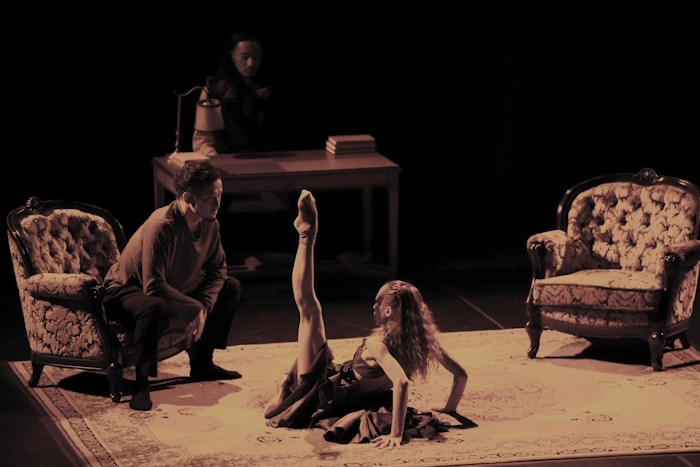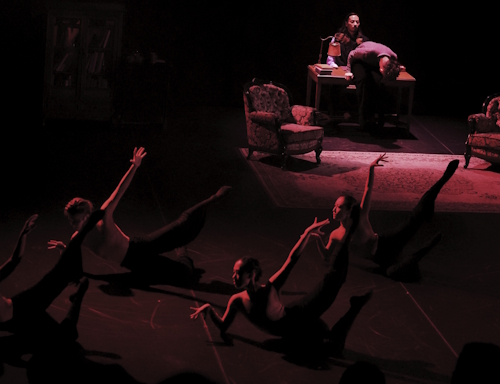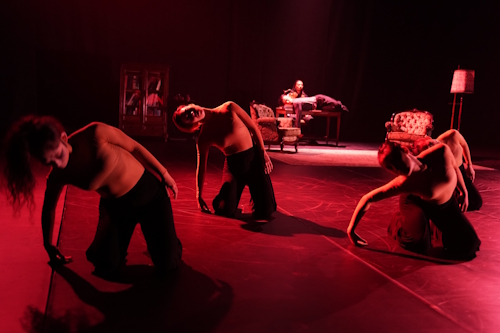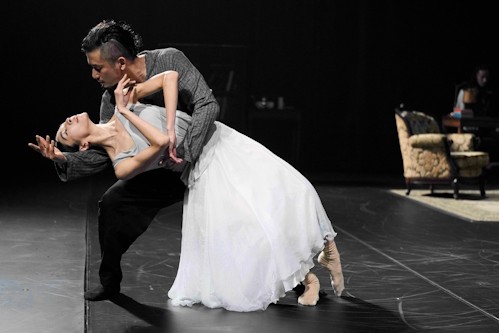The Coronet Theatre, London
17–18 September 2025
The Coronet Theatre is a venue of great character. The stage and audience are almost uncomfortably close to one another; the red walls are peeling, the space feels both outdated and uncanny. With its mix of haunted house and carnival atmosphere, one enters already sensing unease.
On stage, a man sits silently at a desk. The audience files in, chatting and greeting each other, largely ignoring him. Yet he sits as if absent from this world.
This opening is distinctly Japanese. The still body, the prolonged time, the awkward tension in space recall strategies rooted in traditional Japanese theatre, from noh’s sustained stillness to kabuki’s frozen mie poses, moments of deliberate immobility that heighten dramatic tension. Contemporary performance has inherited and transformed these devices, and Naraku continues this lineage: music deliberately detuned, faces alternating between blank masks and grotesquely exaggerated expressions; circular trajectories of movement and near-violent pushing and wrenching; lighting that fractures the performers into multiple shadows. From the outset the piece establishes a dissonant texture, as if pulling the audience into the fissure of a dream.
Choreographer Yoshimitsu Kushida (櫛田祥光), working with Dance Company Lasta, has built a reputation in Tokyo since 2013 for emotionally charged, visually bold work. Naraku (Abyss, 奈落), first staged in Yokohama in 2020 and later adapted into an award-winning film, has been acclaimed at art-film festivals in Paris, Venice, London, and Athens, before arriving at the Coronet for its live UK premiere.
Naraku is a man’s dream. The women on stage never appear as independent figures; they are closer to what Freud called the feminine aspect within the male unconscious: the repressed, the feared, the endlessly returning. The problem is that the women become no more than embodiments of male anxiety, their bodies reduced to instruments of desire and punishment, stripped of their own voice. When these shadow-like figures convulse and dissolve on stage, the unconscious is laid bare, and one cannot help but frown.
This directly echoes Japan’s long-standing patriarchal structures. Women are habitually placed in the position of desire and shadow, reduced to containers for male projection. From horror films to animation, the same motifs recur, and Naraku simply transposes them onto the stage. It does not dismantle these tropes; it luxuriates in them. The result is not critique but a dreamscape steeped in male narcissism.
Kushida drives the movement to extremes: heavy drags, precarious lifts, contact improvisation sharpened to the point where support and oppression are indistinguishable. Dance and language are tightly bound: the actress bearing the image of the mother repeats comments and questions until her voice breaks into hysterical cries of naze? (why?) and dare? (who?). Even without understanding the language, the cadence and the force of movement press down on the body of the spectator. Early in the performance some laughed at the incomprehension, but by the end the pressure erased all laughter.
It is worth noting that the women mostly appear in graceful balletic phrases: elongated lines, poised arms, an idealized vision of beauty. Precisely for this reason, their occasional eruptions into spasms feel violently disruptive, as if the dream had been torn open. Towards the end, the male performer too reveals moments of lyrical openness, as though a repressed femininity were briefly released. These contrasts make the stage bodies contradictory: elegance alongside brutality, desire entangled with shadow.
Lighting multiplies the figures, casting double after double. When the bodies are already violent, these shadows amplify the violence tenfold. The aesthetic recalls Japanese horror cinema and butoh: death and rebirth, body and hallucination. Hijikata Tatsumi (土方 巽), the founder of butoh, explicitly linked women with darkness and shadow, and Naraku follows in this lineage, whether consciously or not.
The violence and symbols of Naraku sit firmly within a broader cultural context. From horror films to butoh, from animation to contemporary theatre, motifs such as “the othered woman,” “drowning and rebirth,” and “splintered selves” are endlessly repeated. This is not a work that asks for immersion. It drags the audience into a cultural nightmare. Such a piece may resist universal narratives, but its Asian characteristics are unmistakable. At the boundary of absurdity and oppression, Naraku reveals Japanese performance’s persistent fascination with extremity.




